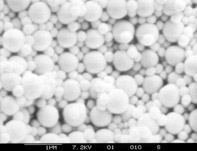
Binary Hard-Sphere Crystallisation Papers

 | Binary Hard-Sphere Crystallisation Papers |  |
Abstract
The possibility of binary hard-sphere colloids crystallising with the cesium chloride (CsCl) structure was examined experimentally using poly (methyl methacrylate) particles dispersed in organic solvents. Towards this end, two dispersions were prepared which contained particles with a radius ratio a=RB/RA, where A refers to the large particles and B the small, of 0.736. This is close to the optimum ratio of 0.732 at which this structure is predicted to form as determined by space-filling calculations. The phases found within the binary mixture were examined using laser light crystallography and scanning electronmicroscopy and some were shown to have the CsCl structure. Over a period of time some of the CsCl crystals disappeared indicating that they were metastable and that this structure may not be the most enduring phase at this size ratio.
pdf version of paper
Abstract
Suspensions of binary mixtures of hard-sphere poly-methylmethacrylate colloidal particles were studied at six different size ratios, a. The main aim was to determine the range of size ratios over which the binary colloidal crystals AB2 and AB13 are stable. Combining these results with those of earlier work, we found stability of AB2 for 0.60=a=0.425., in good agreement with theoretical predictions by computer simulations and cell model methods. AB13 was observed for 0.62=a=0.485, the lower limit being significantly smaller than the theoretical prediction of about 0.525. Rough measurements of crystallization rates showed that AB2 tended to crystallize fastest at small size ration, whereas the opposite was true for AB13. These findings should provide a guide to the optimum conditions for materials applications of these binary colloidal crystals.
pdf version of paper.